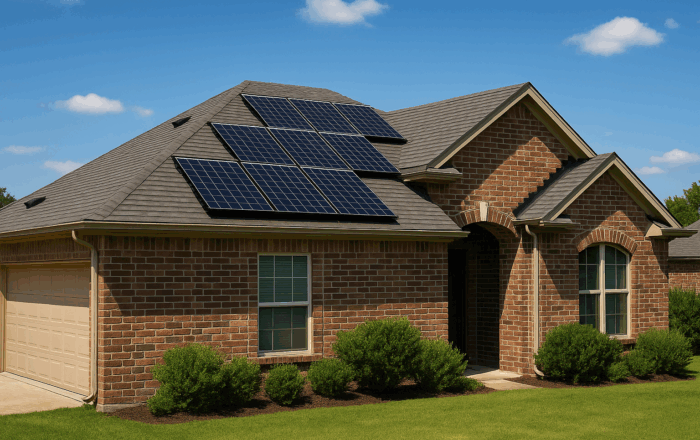Home Improvement Living in Texas
How Many Solar Panels Do You Need in Texas?
4 minute readHow to calculate the number of solar panels you need to power your Texas home
Home > BKV Energy Blog > All Posts > How Much Does It Cost to Run a Hot Tub?
5 minute read • Last update July 2025

Home hot tub installation may be the ultimate in relaxation and indulgence. After all, who wouldn’t want their own spa pool? But, as with many other luxury item purchases, hot tub use comes with additional expenditure that extends beyond the price tag. In this case, increased energy costs.
But precisely how much does it cost to run a hot tub? In this guide, we’ll break down all the key factors and provide a list of helpful tips for using less electricity so that the cost of running a hot tub remains manageable.
Do hot tubs use a lot of electricity? They can, but the impact on your monthly electric bill will vary depending on factors like hot tub size, model, and frequency of use.
When you use your hot tub, the water heater is the main culprit for energy consumption. A 120-volt heater can draw anywhere from 1,500 watts or more, while a 240-volt heater may use as much as 6,000 watts.
Your hot tub water pump can also contribute significantly, typically consuming around 1,500 watts to keep your system running. Altogether, electricity usage often falls between 3 kilowatt-hours (kWh) or 7.5 kWh, depending on the heater voltage.
Top tip: When calculating your hot tub electrical cost, remember that even when not in use, the heater runs intermittently to maintain the water temperature. This can add up quickly, especially if you keep the water at a higher setting.
The total cost of electricity to run a hot tub typically ranges between $30 and $100 per month. Now that we understand the energy required, let’s calculate your hot tub electricity cost more accurately with this simple two-step formula:
This calculation provides a realistic estimate of your hot tub’s electricity cost. Keep in mind, though, that several factors—beyond electricity usage—can influence your hot tub’s monthly cost.
Of the many factors that influence your hot tub energy cost, some are easily controllable—like performing regular hot tub maintenance and avoiding exceeding the maximum recommended temperature. However, factors tied to your location and the specific features of your tub can be more challenging to offset. Let’s explore the essential aspects and see how they contribute to your overall cost.
If you asked homeowners in Dallas and Houston, “How much does it cost to heat a hot tub?” you might get very different answers. Why? It all comes down to climate. Running a hot tub in a cold climate uses more energy, as the heater must work harder to maintain the desired water temperature. Plus, you’ll likely use your hot tub more often in a colder climate, whereas living in a more temperate climate typically equates to less frequent use.
Larger hot tubs hold more water, requiring more energy to heat. A good rule of thumb for estimating the water capacity of a hot tub is to start at 250 gallons per person and add an extra 25 gallons for each person as models go up in size—e.g., a 2-person hot tub holds around 250 gallons, a 4-person tub holds 300 gallons, a six-person tub holds 350 gallons, and so on.
The material used can significantly impact your total hot tub cost per month. For example:
The cabinet (the exterior part of a hot tub) should not affect energy consumption, although it will affect the overall cost. For example, wood and synthetic wood are cheaper than stone or faux stone.
Placement can affect both your initial hot tub installation cost and ongoing expenses:
For these reasons, it’s worth considering placement carefully, as this will have a lasting impact on your long-term energy usage. You may also want to consider installing privacy walls or a wind barrier of some kind to prevent windchill from removing heat from the tub.
Most manufacturers provide guidance on setting temperature preferences, but not all hot tubs automate settings based on energy usage. Buying a new hot tub with energy efficiency technology like economy mode and timers will help you save money by reducing the amount of time your heater and pump are running.
The primary purpose of your filtration system is to keep the water clean, but filtration also affects the total cost of owning a hot tub. For example, outdated or underperforming filters may slowly increase your energy costs over time.
The total cost of running a hot tub depends on how you fit it out. Some accessories will save energy, whereas others will use more:
Selecting features and accessories that fit your budget and needs can make a significant difference over time.
Every savvy hot tub owner knows that proper care is vital for a system that runs smoothly. Plus, being vigilant with regular maintenance could save you a few thousand dollars a year on breakdowns and pricey callouts. Here’s a list of the primary factors to consider.
Maintaining the proper chemical balance is crucial for ensuring that tub water remains clean and safe for use. The bigger your tub, the more chemicals and chemical additives you’ll need. On average, you can expect to spend between $20 to $50 per month on sanitizers, pH adjusters, and shock treatments.
A clean filter ensures optimal water circulation and prevents your pump from overworking. Hot tub filters should be replaced every 1 to 2 years, depending on the type of filter and your usage patterns. A high-quality filter can cost anywhere from $20 to $100.
Routine cleaning prevents debris buildup and helps extend the life of your hot tub. Basic cleaning supplies, like sponges and brushes, typically cost between $10 and $30. For deep cleaning, hiring a professional usually costs between $100 and $200 per session.
You should drain and refill your hot tub every 3 to 4 months. While this is a relatively low-cost task, the water bill can add up, especially if you have a large tub. Expect to pay around $20 to $40 every time.
While you can handle routine maintenance, some hot tub repairs require a professional. For example, anything involving the electrical panel (even if it’s just changing a light bulb) should only be attempted by a licensed electrician. Costs will vary significantly depending on the severity of the issue.
Looking for ways to lower your electricity bill? Check out these top tips for more efficient hot tub use:
As you can see, there are many factors you can control to lower your energy consumption and costs. So, while there’s no black-and-white answer to how much it costs to run a hot tub, there’s plenty you can do as a homeowner to protect yourself from unwanted surprises on your monthly electric bill.
Looking to save even more on energy costs? Then, it’s time to explore BKVE’s range of gimmick-free homeowner electricity plans.
We offer a range of plans tailored to your household’s energy usage, helping you enjoy your hot tub without worrying about skyrocketing energy bills. For example, our Bluebonnet plan helps many Texans save up to $800 annually.
Enter your zip code today to compare rates, find your perfect plan, and start saving on energy with BKVE.
Graham Lumley, Digital Marketing Manager at BKV Energy, leads digital and traditional marketing strategies, focusing on educating Texans about the state's deregulated energy market. With over 8 years of marketing experience, he creates content to help consumers understand and save on their energy bills, bringing a fresh and dynamic approach to the industry.

Home Improvement Living in Texas
How to calculate the number of solar panels you need to power your Texas home

Gardening in Texas presents unique challenges. Long, hot summers and frequent droughts mean that traditional landscaping often requires significant water
Get $50 off your electric bill!
Use code BKVEJOINUS50
Enter your zip code to shop BKV Energy's affordable, fixed-rate Texas electricity plans. Use the promo code for $50 off your electric bill.